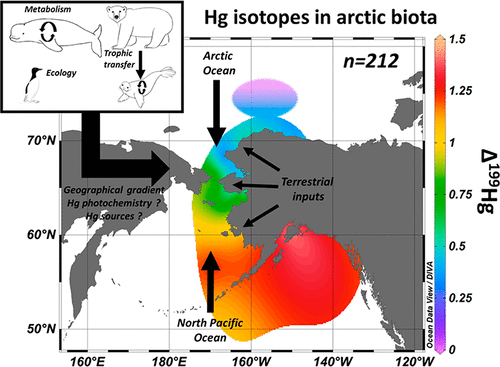当前位置:
X-MOL 学术
›
ACS Earth Space Chem.
›
论文详情
Our official English website, www.x-mol.net, welcomes your
feedback! (Note: you will need to create a separate account there.)
Hg-Stable Isotope Variations in Marine Top Predators of the Western Arctic Ocean
ACS Earth and Space Chemistry ( IF 2.9 ) Pub Date : 2018-04-23 00:00:00 , DOI: 10.1021/acsearthspacechem.8b00017 Jérémy Masbou 1 , Jeroen E. Sonke 1 , David Amouroux 2 , Gaël Guillou 3 , Paul R. Becker 4 , David Point 1
ACS Earth and Space Chemistry ( IF 2.9 ) Pub Date : 2018-04-23 00:00:00 , DOI: 10.1021/acsearthspacechem.8b00017 Jérémy Masbou 1 , Jeroen E. Sonke 1 , David Amouroux 2 , Gaël Guillou 3 , Paul R. Becker 4 , David Point 1
Affiliation

|
Recent studies on mercury (Hg)-stable isotopes in Alaskan seabird eggs and ringed seal livers illustrated the control of sea ice cover on marine methyl-Hg photochemistry. Here, complementary marine mammal tissues have been analyzed to document variations in Hg-, carbon (C)-, and nitrogen (N)-stable isotope compositions of Arctic marine food webs. Hg-stable isotope ratios were measured in liver samples of 55 beluga whales (Delphinapterus leucas) and 15 polar bears (Ursus maritimus) collected since 1990. Large variations in δ202Hg (≈2.1‰) and Δ199Hg (≈1.7‰) are observed between species and within species stocks covering the Gulf of Alaska–Bering Sea–Arctic Ocean regions. Polar bears, mainly feeding on ringed seal (δ15N shift of 4.2‰), show identical liver Δ199Hg of 0.5‰, confirming the absence of metabolic mass-independent fractionation, and 0.33 ± 0.11‰ enrichment in heavy Hg isotopes. Beluga whale liver total Hg concentrations increase with age, reflecting lifetime bioaccumulation, while Hg speciation shifts to inorganic Hg with age as a result of hepatic methyl-Hg breakdown. Δ200Hg variations in biota show a small, 0.1‰ decrease from North Pacific Ocean to Arctic Ocean habitats, suggesting atmospheric Hg deposition to be important in the Pacific and terrestrial Hg inputs to dominate in the Arctic Ocean. Similar to seabird eggs, a consistent south to north gradient in Δ199Hg baseline is seen in mammal liver tissues, confirming sea ice cover as a control factor on marine Hg photoreduction and Δ199Hg. Arctic Ocean beluga whales have near zero Δ199Hg, indicating that terrestrial Hg and in-situ-produced methyl-Hg are not measurably photoreduced in the Arctic Ocean before entering the marine food web.
中文翻译:

西冰洋海洋顶级捕食者中汞稳定同位素的变化
最近对阿拉斯加海鸟卵和环状海豹肝脏中汞(Hg)稳定同位素的研究表明,海洋甲基汞光化学对海冰覆盖的控制。在这里,已经对互补的海洋哺乳动物组织进行了分析,以记录北极海洋食物网的汞,碳(C)和氮(N)稳定同位素组成的变化。汞稳定同位素比率的55白鲸(肝样品中测量学名Delphinapterus leucas)和15只北极熊(熊属maritimus自1990年以来大的变化收集)在δ 202汞柱(≈2.1‰)和Δ 199汞柱(≈1.7‰)在物种之间以及物种覆盖范围内观察到了阿拉斯加湾-白令海-北冰洋地区。北极熊,主要取食环状密封件(δ 15N个移位4.2‰),显示相同的肝Δ 199的Hg 0.5‰,证实不存在代谢质量无关的分馏,和0.33±0.11‰富集重汞柱同位素。白鲸的肝脏总Hg浓度随年龄增长而增加,反映了终生生物积累,而Hg形态因肝甲基Hg分解而随年龄而转变为无机Hg。Δ 200在生物群汞柱的变化示出了小,0.1‰从北太平洋到北冰洋栖息地下降,这表明大气汞沉积是在太平洋和地面汞柱输入主宰北冰洋重要。类似海鸟蛋,一以贯南向北梯度Δ 199汞柱基线被认为是在哺乳动物肝组织,证实海冰覆盖作为海洋汞柱光还原控制因数和Δ 199汞柱。北冰洋白鲸接近零Δ 199汞,表明地面Hg和原位-produced甲基汞不是测量北冰洋进入海洋食物网前光还原。
更新日期:2018-04-23
中文翻译:

西冰洋海洋顶级捕食者中汞稳定同位素的变化
最近对阿拉斯加海鸟卵和环状海豹肝脏中汞(Hg)稳定同位素的研究表明,海洋甲基汞光化学对海冰覆盖的控制。在这里,已经对互补的海洋哺乳动物组织进行了分析,以记录北极海洋食物网的汞,碳(C)和氮(N)稳定同位素组成的变化。汞稳定同位素比率的55白鲸(肝样品中测量学名Delphinapterus leucas)和15只北极熊(熊属maritimus自1990年以来大的变化收集)在δ 202汞柱(≈2.1‰)和Δ 199汞柱(≈1.7‰)在物种之间以及物种覆盖范围内观察到了阿拉斯加湾-白令海-北冰洋地区。北极熊,主要取食环状密封件(δ 15N个移位4.2‰),显示相同的肝Δ 199的Hg 0.5‰,证实不存在代谢质量无关的分馏,和0.33±0.11‰富集重汞柱同位素。白鲸的肝脏总Hg浓度随年龄增长而增加,反映了终生生物积累,而Hg形态因肝甲基Hg分解而随年龄而转变为无机Hg。Δ 200在生物群汞柱的变化示出了小,0.1‰从北太平洋到北冰洋栖息地下降,这表明大气汞沉积是在太平洋和地面汞柱输入主宰北冰洋重要。类似海鸟蛋,一以贯南向北梯度Δ 199汞柱基线被认为是在哺乳动物肝组织,证实海冰覆盖作为海洋汞柱光还原控制因数和Δ 199汞柱。北冰洋白鲸接近零Δ 199汞,表明地面Hg和原位-produced甲基汞不是测量北冰洋进入海洋食物网前光还原。









































 京公网安备 11010802027423号
京公网安备 11010802027423号